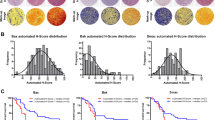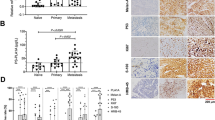Abstract
Breast cancer metastasis suppressor 1 (BRMS1) has been reported to suppress metastasis without significantly affecting tumorigenicity in breast cancer and ovarian cancer. To investigate the role of BRMS1 in human melanoma progression and prognosis, we established tissue microarray and BRMS1 expression was evaluated by immunohistochemistry in 41 dysplastic nevi, 90 primary melanomas and 47 melanoma metastases. We found that BRMS1 expression was significantly decreased in metastatic melanoma compared with primary melanoma or dysplastic nevi (P=0.021 and 0.001, respectively, χ2 test). In addition, reduced BRMS1 staining was significantly correlated with American Joint Committee on Cancer stages (P=0.011, χ2 test), but not associated with tumor thickness, tumor ulceration and other clinicopathological parameters. Furthermore, BRMS1 expression was significantly correlated with disease-specific 5-year survival of melanoma patients (P=0.007, log-rank test). Multivariate Cox regression analysis revealed that BRMS1 staining was an independent prognostic factor for melanoma patients (relative risk=0.51; confidence interval=0.29–0.91; P=0.022). Moreover, we demonstrated that BRMS1 overexpression inhibited endothelial cell growth and tube formation ability by suppressing NF-κB activity and IL-6 expression in vitro. We also showed that knockdown of BRMS1 increased IL-6 expression and promoted endothelial cell growth and tube formation. In addition, our data revealed that the BRMS1-mediated IL-6 expression is dependent on NF-κB. Strikingly, our in vivo studies using nude mice confirmed that BRMS1 inhibited blood vessel formation and the recruitment of CD31-positive cells in matrigel plugs. Taken together, BRMS1 expression was decreased in metastatic melanomas, which resulted in deficient suppression of angiogenesis and contributed to melanoma progression. BRMS1 may serve an important prognostic marker and therapeutic target for melanoma patients.
This is a preview of subscription content, access via your institution
Access options
Subscribe to this journal
Receive 50 print issues and online access
$259.00 per year
only $5.18 per issue
Buy this article
- Purchase on Springer Link
- Instant access to full article PDF
Prices may be subject to local taxes which are calculated during checkout







Similar content being viewed by others
References
Angeletti CA, Lucchi M, Fontanini G, Mussi A, Chella A, Ribechini A et al. (1996). Prognostic significance of tumoral angiogenesis in completely resected late stage lung carcinoma (stage IIIA-N2). Impact of adjuvant therapies in a subset of patients at high risk of recurrence. Cancer 78: 409–415.
Balch CM, Buzaid AC, Soong SJ, Atkins MB, Cascinelli N, Coit DG et al. (2001). Final version of the American Joint Committee on Cancer staging system for cutaneous melanoma. J Clin Oncol 19: 3635–3648.
Ballo MT, Ang KK . (2003). Radiation therapy for malignant melanoma. Surg Clin North Am 83: 323–342.
Brawer MK . (1996). Screening and early detection of prostate cancer will decrease morbidity and mortality from prostate cancer: the argument for. Eur Urol 29 (Suppl 2): 19–23.
Cicek M, Fukuyama R, Cicek MS, Sizemore S, Welch DR, Sizemore N et al. (2009). BRMS1 contributes to the negative regulation of uPA gene expression through recruitment of HDAC1 to the NF-kappaB binding site of the uPA promoter. Clin Exp Metastasis 26: 229–237.
Cicek M, Fukuyama R, Welch DR, Sizemore N, Casey G . (2005). Breast cancer metastasis suppressor 1 inhibits gene expression by targeting nuclear factor-kappaB activity. Cancer Res 65: 3586–3595.
Czubayko F, Schulte AM, Berchem GJ, Wellstein A . (1996). Melanoma angiogenesis and metastasis modulated by ribozyme targeting of the secreted growth factor pleiotrophin. Proc Natl Acad Sci USA 93: 14753–14758.
Dai DL, Martinka M, Li G . (2005). Prognostic significance of activated Akt expression in melanoma: a clinicopathologic study of 292 cases. J Clin Oncol 23: 1473–1482.
Dai J, Peng L, Fan K, Wang H, Wei R, Ji G et al. (2009). Osteopontin induces angiogenesis through activation of PI3K/AKT and ERK1/2 in endothelial cells. Oncogene 28: 3412–3422.
Dauda MM, Shehu SM . (2005). Malignant melanoma: a review. Niger Postgrad Med J 12: 125–130.
Diao H, Kon S, Iwabuchi K, Kimura C, Morimoto J, Ito D et al. (2004). Osteopontin as a mediator of NKT cell function in T cell-mediated liver diseases. Immunity 21: 539–550.
Folkman J . (2002). Role of angiogenesis in tumor growth and metastasis. Semin Oncol 29: 15–18.
Garate M, Campos EI, Bush JA, Xiao H, Li G . (2007). Phosphorylation of the tumor suppressor p33(ING1b) at Ser-126 influences its protein stability and proliferation of melanoma cells. Faseb J 21: 3705–3716.
Gasparini G, Weidner N, Maluta S, Pozza F, Boracchi P, Mezzetti M et al. (1993). Intratumoral microvessel density and p53 protein: correlation with metastasis in head-and-neck squamous-cell carcinoma. Int J Cancer 55: 739–744.
Grossman D, Altieri DC . (2001). Drug resistance in melanoma: mechanisms, apoptosis, and new potential therapeutic targets. Cancer Metastasis Rev 20: 3–11.
Hedley BD, Welch DR, Allan AL, Al-Katib W, Dales DW, Postenka CO et al. (2008). Downregulation of osteopontin contributes to metastasis suppression by breast cancer metastasis suppressor 1. Int J Cancer 123: 526–534.
Hersey P . (2003). Adjuvant therapy for high-risk primary and resected metastatic melanoma. Intern Med J 33: 33–43.
Hicks DG, Yoder BJ, Short S, Tarr S, Prescott N, Crowe JP et al. (2006). Loss of breast cancer metastasis suppressor 1 protein expression predicts reduced disease-free survival in subsets of breast cancer patients. Clin Cancer Res 12: 6702–6708.
Hollingsworth HC, Kohn EC, Steinberg SM, Rothenberg ML, Merino MJ . (1995). Tumor angiogenesis in advanced stage ovarian carcinoma. Am J Pathol 147: 33–41.
Hurst DR, Edmonds MD, Scott GK, Benz CC, Vaidya KS, Welch DR . (2009). Breast cancer metastasis suppressor 1 up-regulates miR-146, which suppresses breast cancer metastasis. Cancer Res 69: 1279–1283.
Karst AM, Gao K, Nelson CC, Li G . (2009). Nuclear factor kappa B subunit p50 promotes melanoma angiogenesis by upregulating interleukin-6 expression. Int J Cancer 124: 494–501.
Kauffman EC, Robinson VL, Stadler WM, Sokoloff MH, Rinker-Schaeffer CW . (2003). Metastasis suppression: the evolving role of metastasis suppressor genes for regulating cancer cell growth at the secondary site. J Urol 169: 1122–1133.
Li G, Tang L, Zhou X, Tron V, Ho V . (1998). Chemotherapy-induced apoptosis in melanoma cells is p53 dependent. Melanoma Res 8: 17–23.
Maeda K, Chung YS, Takatsuka S, Ogawa Y, Onoda N, Sawada T et al. (1995). Tumour angiogenesis and tumour cell proliferation as prognostic indicators in gastric carcinoma. Br J Cancer 72: 319–323.
Maffey AH, Ishibashi T, He C, Wang X, White AR, Hendy SC et al. (2007). Probasin promoter assembles into a strongly positioned nucleosome that permits androgen receptor binding. Mol Cell Endocrinol 268: 10–19.
Mansfield PF, Lee JE, Balch CM . (1994). Cutaneous melanoma: current practice and surgical controversies. Curr Probl Surg 31: 253–374.
Meehan WJ, Samant RS, Hopper JE, Carrozza MJ, Shevde LA, Workman JL et al. (2004). Breast cancer metastasis suppressor 1 (BRMS1) forms complexes with retinoblastoma-binding protein 1 (RBP1) and the mSin3 histone deacetylase complex and represses transcription. J Biol Chem 279: 1562–1569.
Meehan WJ, Welch DR . (2003). Breast cancer metastasis suppressor 1: update. Clin Exp Metastasis 20: 45–50.
Metge BJ, Frost AR, King JA, Dyess DL, Welch DR, Samant RS et al. (2008). Epigenetic silencing contributes to the loss of BRMS1 expression in breast cancer. Clin Exp Metastasis 25: 753–763.
Ostmeier H, Fuchs B, Otto F, Mawick R, Lippold A, Krieg V et al. (1999). Can immunohistochemical markers and mitotic rate improve prognostic precision in patients with primary melanoma? Cancer 85: 2391–2399.
Phadke PA, Vaidya KS, Nash KT, Hurst DR, Welch DR . (2008). BRMS1 suppresses breast cancer experimental metastasis to multiple organs by inhibiting several steps of the metastatic process. Am J Pathol 172: 809–817.
Remmele W, Stegner HE . (1987). Recommendation for uniform definition of an immunoreactive score (IRS) for immunohistochemical estrogen receptor detection (ER-ICA) in breast cancer tissue. Pathologe 8: 138–140.
Samant RS, Clark DW, Fillmore RA, Cicek M, Metge BJ, Chandramouli KH et al. (2007). Breast cancer metastasis suppressor 1 (BRMS1) inhibits osteopontin transcription by abrogating NF-kappaB activation. Mol Cancer 6: 6.
Samant RS, Seraj MJ, Saunders MM, Sakamaki TS, Shevde LA, Harms JF et al. (2000). Analysis of mechanisms underlying BRMS1 suppression of metastasis. Clin Exp Metastasis 18: 683–693.
Seraj MJ, Harding MA, Gildea JJ, Welch DR, Theodorescu D . (2000a). The relationship of BRMS1 and RhoGDI2 gene expression to metastatic potential in lineage related human bladder cancer cell lines. Clin Exp Metastasis 18: 519–525.
Seraj MJ, Samant RS, Verderame MF, Welch DR . (2000b). Functional evidence for a novel human breast carcinoma metastasis suppressor, BRMS1, encoded at chromosome 11q13. Cancer Res 60: 2764–2769.
Shevde LA, Samant RS, Goldberg SF, Sikaneta T, Alessandrini A, Donahue HJ et al. (2002). Suppression of human melanoma metastasis by the metastasis suppressor gene, BRMS1. Exp Cell Res 273: 229–239.
Soengas MS, Lowe SW . (2003). Apoptosis and melanoma chemoresistance. Oncogene 22: 3138–3151.
Standal T, Borset M, Sundan A . (2004). Role of osteopontin in adhesion, migration, cell survival and bone remodeling. Exp Oncol 26: 179–184.
Struhl K . (1995). Yeast transcriptional regulatory mechanisms. Annu Rev Genet 29: 651–674.
Thompson JF, Scolyer RA, Kefford RF . (2005). Cutaneous melanoma. Lancet 365: 687–701.
Tsao H, Sober AJ . (2005). Melanoma treatment update. Dermatol Clin 23: 323–333.
Vaidya KS, Harihar S, Phadke PA, Stafford LJ, Hurst DR, Hicks DG et al. (2008). Breast cancer metastasis suppressor-1 differentially modulates growth factor signaling. J Biol Chem 283: 28354–28360.
Weidner N . (1995). Intratumor microvessel density as a prognostic factor in cancer. Am J Pathol 147: 9–19.
Weidner N, Carroll PR, Flax J, Blumenfeld W, Folkman J . (1993). Tumor angiogenesis correlates with metastasis in invasive prostate carcinoma. Am J Pathol 143: 401–409.
Weidner N, Semple JP, Welch WR, Folkman J . (1991). Tumor angiogenesis and metastasis--correlation in invasive breast carcinoma. N Engl J Med 324: 1–8.
Welch DR, Goldberg SF . (1997). Molecular mechanisms controlling human melanoma progression and metastasis. Pathobiology 65: 311–330.
Wiggins DL, Granai CO, Steinhoff MM, Calabresi P . (1995). Tumor angiogenesis as a prognostic factor in cervical carcinoma. Gynecol Oncol 56: 353–356.
Yamazaki K, Abe S, Takekawa H, Sukoh N, Watanabe N, Ogura S et al. (1994). Tumor angiogenesis in human lung adenocarcinoma. Cancer 74: 2245–2250.
Yang J, Zhang B, Lin Y, Yang Y, Liu X, Lu F . (2008). Breast cancer metastasis suppressor 1 inhibits SDF-1alpha-induced migration of non-small cell lung cancer by decreasing CXCR4 expression. Cancer Lett 269: 46–56.
Zainabadi K, Benyamini P, Chakrabarti R, Veena MS, Chandrasekharappa SC, Gatti RA et al. (2005). A 700-kb physical and transcription map of the cervical cancer tumor suppressor gene locus on chromosome 11q13. Genomics 85: 704–714.
Zhang S, Lin QD, Di W . (2006). Suppression of human ovarian carcinoma metastasis by the metastasis-suppressor gene, BRMS1. Int J Gynecol Cancer 16: 522–531.
Acknowledgements
We thank Steve Hendy for technical assistance with EMSA. This work was supported by the Canadian Institutes of Health Research (MOP-84559 and MOP-93810) and Canadian Dermatology Foundation to GL. JL is a recipient of Postgraduate Scholarship from the Natural Sciences and Engineering Research Council of Canada and University of British Columbia Graduate Fellowship. Both JL and YC are recipients of CIHR Skin Research Training Centre Trainee Award.
Author information
Authors and Affiliations
Corresponding author
Ethics declarations
Competing interests
The authors declare no conflict of interest.
Additional information
Supplementary Information accompanies the paper on the Oncogene website
Supplementary information
Rights and permissions
About this article
Cite this article
Li, J., Cheng, Y., Tai, D. et al. Prognostic significance of BRMS1 expression in human melanoma and its role in tumor angiogenesis. Oncogene 30, 896–906 (2011). https://doi.org/10.1038/onc.2010.470
Received:
Revised:
Accepted:
Published:
Issue Date:
DOI: https://doi.org/10.1038/onc.2010.470
Keywords
This article is cited by
-
BRMS1: a multifunctional signaling molecule in metastasis
Cancer and Metastasis Reviews (2020)
-
Genetics of metastasis: melanoma and other cancers
Clinical & Experimental Metastasis (2018)
-
Breast carcinoma metastasis suppressor gene 1 (BRMS1): update on its role as the suppressor of cancer metastases
Cancer and Metastasis Reviews (2015)
-
BRMS1L suppresses breast cancer metastasis by inducing epigenetic silence of FZD10
Nature Communications (2014)
-
Effect of BRMS1 on Tumorigenicity and Metastasis of Human Rectal Cancer
Cell Biochemistry and Biophysics (2014)



